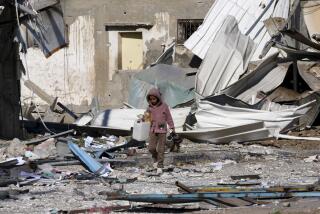Unraveling Webs of Mental, Physical Wounds
NEW YORK — Everyone told Emman that getting around Brooklyn was simple. Go down a block and hop the shuttle known as the “dollar van.” But the mere sight of the dark-colored van with tinted windows made him run and hide.
It reminded him of the van that used to kidnap him from his home in Nigeria and deliver him to his torturers.
“I couldn’t enter the dollar van. It gave me the creeps,” said the tall, soft-spoken African. “I would rather walk for miles, really, than to take that ride. Because the strike force in my country--they’re the ones who tortured me--that’s the van they use for abducting people.”
If Emman, a former lawyer, can smile about it now, it’s partly thanks to nine months of treatment at the Bellevue/NYU Program for Survivors of Torture. It is one of 14 such centers that have opened in the United States since 1985, offering medical and psychiatric care to people like Emman.
Emman, 27, says he nearly died during weeks of torture. He still has nightmares, and the stress of retelling his story made his nose bleed. He doesn’t want his surname published, fearing reprisals against his family in Nigeria.
“Comparing my experience and my problems with other survivors here at the clinic is an enormous help,” he says. “Part of the therapy is starting a new life. I’ve gotten engaged and will be married in March. That tells me something. I’m on a new plane.”
Although the process of recovery will be a long one, Emman’s treatment was so successful that he even took his fiancee for a ride in a dollar van.
Dr. Allen Keller, a physician who co-founded Bellevue’s program with psychologist Jack Saul, said that treating torture victims is complicated because physical and mental wounds are intertwined, and sustained support is essential.
“The interface between the mental and the physical is critical. You can’t separate where the medical problems end and where the psychological problems begin. . . . We have medical doctors, psychiatrists, psychologists, social workers, rehabilitation medicine specialists, gynecologists,” he said.
A Tibetan survivor had to be put in an isolation room to treat his tuberculosis, but enforced seclusion brought his psychological trauma rushing back, so the mental and physical healing had to go hand in hand.
At Bellevue, weekly support groups cater to English- and French-speaking Africans and Tibetans, and groups are being established for Bosnians and female victims.
Specialists on the staff of Bellevue Hospital and New York University School of Medicine are allocating some of their time to work at the program and are paid out of private grants.
The clinics nationwide have linked up as a national consortium to deal with policy issues, conduct joint research and help immigration officials to better understand the symptoms and needs of torture survivors.
Last October the Torture Victims’ Relief Act was passed, authorizing $31 million in federal funds to help treat torture victims here and abroad. But little money has been allocated, and many treatment centers survive on private and local government grants.
Keller said the clinic receives five to 10 requests for referrals a week and has treated more than 300 torture survivors from 40 countries since the program began in 1995.
“Tragically,” Keller said, “demand for our services is booming.”
More to Read
Sign up for Essential California
The most important California stories and recommendations in your inbox every morning.
You may occasionally receive promotional content from the Los Angeles Times.










